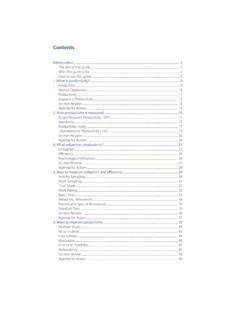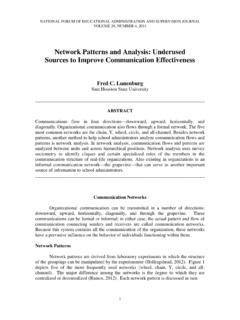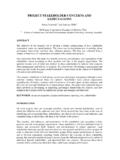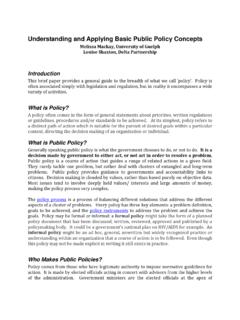Transcription of Team Building: Managing the norms of informal …
1 team building Managing the norms of informal Groups in the Workplace Introduction Jeff Lane was at his wits end. As a newly appointed production manager, he had tried virtually everything to get his work group to come up to production standard. The equipment was operating properly, and the group had the training and experience to meet expectations, yet it was not perform- ing well. What was wrong? And what could he do to correct the situation? Managers and supervisors frequently face such a dilemma-standards that should be met but aren't for what seems like no apparent reason. What Jeff Lane and other managers/ supervisors sometimes fail to realize is that within every organization there are often informal group pressures that influence and regulate individual behavior. informal groups formulate an implicit code of ethics or an unspoken set of standards establishing acceptable behavior In Jeff 's department, the informal group may have established a norm below that set by the organization, subtly exercising control over its members regarding the amount of output.
2 The dynamics of informal groups spective of the formal group, norms informal groups almost always arise generally fall into three categories- if opportunities exist. Often, these positive, negative, and neutral. In groups serve a counter organizational other words, norms either support, function, attempting to counteract the obstruct, or have no effect on the coercive tendencies in an organization. aims of the larger organization. If management prescribes production For example, it the informal norms that the group considers un- group in Jeff 's shop set a norm fair, for instance, the group's recourse supporting high output, that norm is to adopt less demanding norms and would have been more potent than to use its ingenuity to discover ways in any attempt by Jeff to coerce compli- which it can sabotage management's ance with the standard.
3 The reason aims of this article imposed standards. is simple, yet profound. The norm is Explore the dynamics of informal workgroups in informal groups have a pow- of the group members own making, the workplace erful influence on the effectiveness and is not one imposed upon them. of an organization, and can even There is a big motivational difference subvert its formal goals. But the between being told what to do and Define the key dynamics in informal workgroups informal group's role is not limited being anxious to do it. to resistance. The impact of the If Jeff had been aware of group Illustrate these dynamics with a number of informal group upon the larger dynamics, he might have realized examples of how they may operate formal group depends on the norms that informal groups can be either that the informal group sets.
4 So the his best friend or his worst enemy. Suggest a 3 step approach to improve existing informal group can make the formal He should have been sensitive to group norms organization more effective, too. the informal groups within his A norm is an implied agree- area and he should have cultivated ment among the group's member- their goodwill and cooperation and ship regarding how members in the made use of the informal group group should behave. From the per- leadership. That is, he should have People need to belong, to be many of these characteristics are wooed the leadership of the in- liked, to feel a part of something. similar to those of formal organiza- formal group and enlisted the Because the informal group can tions, others are unique. One attri- support of its membership to withhold this attractive reward, it bute of informal groups is rotational achieve the formal organization's has a tool of its own to coerce com- leadership.
5 Aims. The final effect of his ac- pliance with its norms . The informal leader emerges tions might have been positive as the individual possessing qualities or negative, depending upon the Identity and self esteem that the other members perceive as agreement or lack of it between Groups also provide a means of critical to the satisfaction of their the informal group and himself. developing, enhancing, and con- specific needs at the moment; as Harnessing the power of firming a person's sense of identity the needs change so does the leader. informal groups is no easy task. and self-esteem. Although many Only rarely does a single individual The requirements include: organizations attempt to recognize possess all of the leadership char- an understanding of group these higher needs, the nature of acteristics needed to fill the various dynamics and, some jobs-their technology and needs of the group.
6 An ability to bring about environment-precludes this from Unlike the formally appointed changes in informal group happening. The long assembly line leader who has a defined position norms that positively rein- or endless rows of desks reinforce a from which to influence others, the force the formal organiza- feeling of depersonalization. informal leader does not possess tion's goals. formal power. If the informal leader As a starting point, managers Stress reduction fails to meet the group's expectations, and supervisors should at least Another function of groups is to he or she is deposed and replaced be aware of the reasons behind serve as an agent for establish- by another. The informal group's informal group formation and the ing and testing social reality. For judgment of its leaders tends to be properties and characteristics of instance, several individuals may quicker and more cold-blooded than these groups.
7 Share the feeling that their super- that of most formal groups. visor is a slave driver or that their Formation of informal groups working conditions are inadequate. Supervisory strategies Individuals are employed by an By developing a consensus about The supervisor can use several strate- organization to perform specific these feelings, group members are gies to affect the leadership and har- functions. Although the whole able to reduce the anxiety associated ness the power of informal groups. person joins an organization, at- with their jobs. One quick and sure method of chang- tention is usually focused on the ing a group is to cause the leader to partial person, the part of the indi- All for one, one for all change one or more of his or her vidual doing the job. Because peo- Finally, the informal group serves as characteristics.
8 Another is to replace ple have needs that extend beyond a defense mechanism against forces the leader with another person. the work itself, informal groups that group members could not re- One common ploy is to sys- develop to fill certain emotional, sist on their own. Joining forces in tematically rotate out of the group social, and psychological needs. a small group makes the members its leaders and its key members. The degree to which a group feel stronger, less anxious, and less Considering the rotational nature satisfies its members needs deter- insecure in the face of a perceived of leadership, a leader may emerge mines the limits within which threat. who has aims similar to the formal individual members of the group As long as needs exist that are goals of the organization. There are will allow their behavior to be not served by the formal organiza- problems with this approach, how- controlled by the group.
9 Tion, informal groups will form to ever. Besides the practical difficul- fill the gap. Since the group fills many ties of this, such strategy is blunted Sense of belonging important needs for its members, it by the fact that group norms often Several major functions are served influences member behavior. persist long after the leader has left by informal groups. For example, the group. the group serves as a means of sat- Leadership of informal groups A less Machiavellian ap- isfying the affiliation needs of its informal groups possess certain proach is for the supervisor to be members for friendship and sup- characteristics that, if understood, alert to leaders sympathetic to the port. can be used to advantage. While supervisor's objectives and to use | informal Group norms them toward the betterment of the informal group cohesiveness to increase the groups cohesiveness formal group's effectiveness.
10 Still A third characteristic of informal deliberately devising situations that another method is to attempt to groups is group cohesiveness-the put one group into competition co-opt' informal leaders by absorb- force that holds a group together. with another. If this gambit is care- ing them into the leadership or the Group cohesiveness varies widely fully controlled the solidarity that decision-making structure of the based on numerous factors-includ- results may bring a higher level of formal group. Co-opting the infor- ing the size of the group depen- performance. mal leader often serves as a means dence of members upon the group The danger of this strategy is of averting threats to the stability of achievement of goals status of the that the supervisor may be unable the formal organization. group and management demands to control the reaction of the group.









